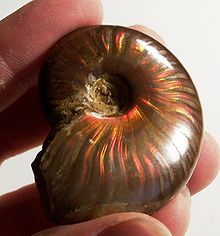Ammonites
The name “ammonite”, from which the scientific term is derived, was inspired by the spiral shape of their fossilized shells, which somewhat resemble tightly coiled rams‘ horns. Pliny the Elder (d. 79 AD near Pompeii) called fossils of these animals ammonis cornua (“horns of Ammon”) because the Egyptian god Ammon (Amun) was typically depicted wearing ram’s horns.[1] Often the name of an ammonite genus ends in –ceras, which is Greek (κέρας) for “horn”.
In medieval Europe, fossilised ammonites were thought to be petrified coiled snakes, and were called “snakestones” or, more commonly in medieval England, “serpentstones”. They were considered to be evidence for the actions of saints, such as Hilda of Whitby, a myth referenced in Sir Walter Scott‘s Marmion,[13] and Saint Patrick, and were held to have healing or oracular powers. Traders would occasionally carve the head of a snake onto the empty, wide end of the ammonite fossil, and then sell them as petrified snakes. In other cases, the snake’s head would be simply painted on.[14] Ammonites from the Gandaki river in Nepal are known as saligrams, and are believed by Hindus to be a concrete manifestation of God or Vishnu.[15
When ammonites are found in clays, their original mother-of-pearl coating is often preserved. This type of preservation is found in ammonites such as Hoplites from the Cretaceous Gault clay of Folkestone in Kent, England.
The Cretaceous Pierre Shale formation of the United States and Canada is well known for the abundant ammonite fauna it yields, including Baculites, Placenticeras, Scaphites, Hoploscaphites, and Jeletzkytes, as well as many uncoiled forms. Many of these also have much or all of the original shell, as well as the complete body chamber, still intact. Many Pierre Shale ammonites, and indeed many ammonites throughout earth history, are found insideconcretions.
The majority of ammonoid specimens, especially those of the Paleozoic era, are preserved only as internal molds; the outer shell (composed of aragonite)[11] has been lost during the fossilization process. Only in these internal-mold specimens can the suture lines be observed; in life, the sutures would have been hidden by the outer shell.
The ammonoids as a group continued through several major extinction events, although often only a few species survived. Each time, however, this handful of species diversified into a multitude of forms. Ammonite fossils became less abundant during the latter part of the Mesozoic, with none surviving into the Cenozoic era. The last surviving lineages disappeared, along with the non-avian dinosaurs, 65 Mya in the Cretaceous–Paleogene extinction event. The reason why no ammonites survived theextinction event at the end of the Cretaceous, whereas some nautiloids survived, might be due to differences in ontogeny. If their extinction was due to a bolide strike, plankton around the globe could have been severely diminished, thereby dooming ammonite reproduction during its planktonic stage
Size[edit]

2-metre (6.5-foot) Parapuzosia seppenradensis cast in Germany
Few of the ammonites occurring in the lower and middle part of the Jurassic period reached a size exceeding 23 cm (9 in) in diameter. Much larger forms are found in the later rocks of the upper part of the Jurassic and the lower part of the Cretaceous, such as Titanites from the Portland Stone of Jurassic of southern England, which is often 53 cm (2 ft) in diameter, andParapuzosia seppenradensis of the Cretaceous period of Germany, which is one of the largest known ammonites, sometimes reaching 2 m (6.5 ft) in diameter. The largest documented North American ammonite is Parapuzosia bradyi from the Cretaceous, with specimens measuring 137 cm (4.5 ft) in diameter.
Amatol is rare today, except in legacy munitions or unexploded ordnance. A form of amatol exists under a different name — ammonite. Ammonite is a civilian explosive, generally comprising a 20/80 mixture of TNT and ammonium nitrate. Typically, it is used for quarrying or mining purposes. It is a popular civil engineering explosive inEastern Europe and China.
Because the proportion of TNT is significantly lower than in its military counterpart, ammonite has much less destructive power; given ammonite’s use, this is not a problem. In general, a 30 kilogram charge of ammonite is roughly equivalent to 20 kilograms of TNT.
